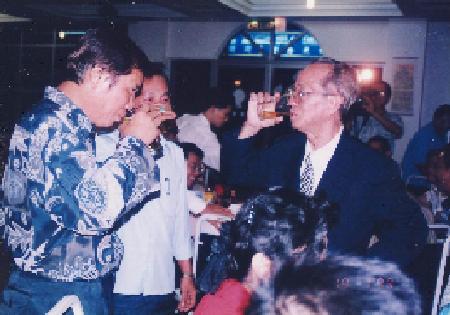WHICH OF THE ARTS TO TEACH?

Grandmaster Wong drinking to the health of his sifu, Grandmaster Ho Fatt Nam
Question
Our school, Shaolin Wahnam, is named after our two patriarchs, Sitaigung Lai Chin Wah and Sitaigung Ho Fatt Nam. How do you decide which of the Sitaigung Lai's or Sitaigung Ho's art to teach us?
-- Juan, Colombia
Answer
Our school is called Shaolin Wahnam. "Shaolin" is obvious. The arts we teach originated from the Shaolin Temple, the imperial temple of China regarded by many as the pinnacle of kungfu. We also teach Taijiquan, which originated from Shaolin Kungfu.
What about the other term, "Wahnam"? Some people who know Chinese mistakenly think that it means "South of China", as that can be the literal meaning of the two words "wah" and "nam", which is in Cantonese pronunciation. In Mandarin they are pronounced as "hua" and "nan", though the written words are the same. But that is not the actual meaning.
"Wahnam" is taken from the name of my two teachers, “Wah" from Sifu Lai Chin Wah, and "Nam" from Sifu Ho Fatt Nam. My other two teachers were Sifu Chee Kim Thong and Sifu Choe Hoong Choy.
All my four teachers were patriarchs of their arts. This was no co-incidence. Except for my first teacher whom I was led to by divine guidance at the age of 10, I sought the best teachers to learn from.
Sifu Lai Chin Wah was better known as Uncle Righteousness and was the patriarch of Southern Shaolin, popularly called by the general public today as Hoong Ka Kungfu. Sifu Chee Kim Thong was regarded as the Living Treasure of China. Sifu Ho Fatt Nam was the third generation successor from the southern Shaolin Temple. Sifu Choe Hoong Choy was the patriarch of Choe Family Wing Choon Kungfu.
Most of the arts I teach came from Uncle Righteousness and Sifu Ho Fatt Nam, some were from Sifu Chee Kim Thong and Sifu Choe Hoong Choy. Hence, I named my school "Wahnam". Naming it "Wah-Thong-Nam-Choy", in the order I learned from my sifus, would be too long a name.
I did not and do not consciously decide which of the arts from my sifus to teach. I teach what I consider the best for the needs and aspirations of my students. What I learned from my sifus has been integrated, though if I examine the instructional material closely I can trace its source of greatest influence.
The source of greatest influence is mostly traced back to Uncle Righteousness or Sifu Ho Fatt Nam. This is the result rather than the cause of my teaching material. In other words, I did not consciously select from what I had learned from my teachers, and then teach it to my students. Rather I taught what was best for the students, and on looking back I could trace its sources. Almost always the sources were not from one teacher but from all my teachers, though I could usually tell the source of greatest influence.
Much of the form I teach was from Uncle Righteousness. Uncle Righteousness was very particular on stance training and picture-perfect form. Many people have kindly commented that my stances are solid and my form perfect. This is the legacy of Uncle Righteousness.
Much of force training and combat application came from Sifu Ho Fatt Nam. Sifu Ho Fatt Nam emphasized that force training and combat application were the twin pillars of kungfu training. Many people also have kindly commented that I have much internal force and that I can handle any combat situation. This is the legacy of Sifu Ho Fatt Nam.
More important than the forms, internal force and combat application is the moral and spiritual teaching. As his honorific nickname indicates, Uncle Righteousness was well known for righteousness as well as courage. Sifu Ho Fatt Nam was famous for wisdom and compassion. These values -- righteousness, courage, wisdom and compassion -- have been ingrained in our school
I also have learnt many invaluable lessons from Sifu Chee Kim Thong and Sifu Choe Hoong Choy, and our school has benefited tremendously. If I were asked to name the most outstanding lesson, I would say "mm men yong lak" or "don't use muscular strength" from Sifu Chee Kim Thong, and "sum yap chean chuit" or "profundity in simplicity" from Sifu Choe Hoong Choy.
So, the next time you are asked to relax, which is one of the most widely given instructions in our school, you can remind yourself that it is the legacy of Sifu Chee Kim Thong. When you find that a simple movement can have many amazing results, you are reminded of the legacy of Sifu Choe Hoong Choy.
LINKS
